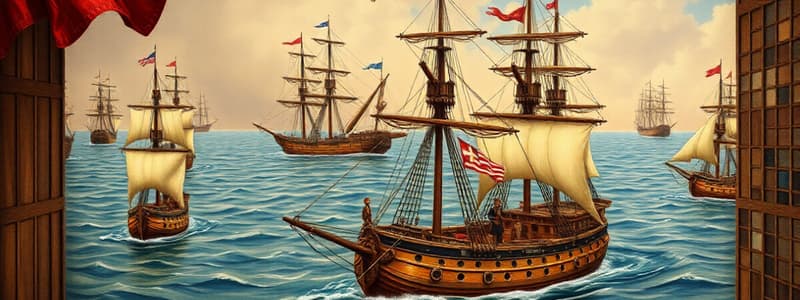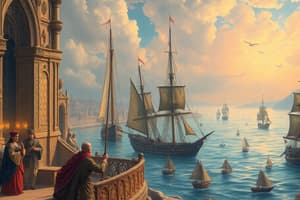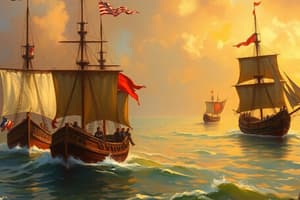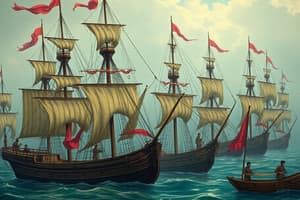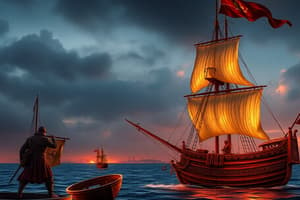Podcast
Questions and Answers
Who led the U.S. Navy squadron to blockade Tripoli in May 1801?
Who led the U.S. Navy squadron to blockade Tripoli in May 1801?
- President Thomas Jefferson
- Commodore Richard Dale (correct)
- Bashaw Yusuf Karamanli
- Commodore Stephen Decatur
The United States initially chose to confront Barbary piracy militarily under President George Washington.
The United States initially chose to confront Barbary piracy militarily under President George Washington.
False (B)
What was the main reason for the United States to engage in conflicts with the Barbary States?
What was the main reason for the United States to engage in conflicts with the Barbary States?
To ensure American maritime security and protect merchant ships.
In 1815, President _____ sent a naval force to the Mediterranean to address the ongoing threats from the Barbary States.
In 1815, President _____ sent a naval force to the Mediterranean to address the ongoing threats from the Barbary States.
Which of the following was a consequence of Barbary piracy for the United States?
Which of the following was a consequence of Barbary piracy for the United States?
Commodore Stephen Decatur played a significant role in the Second Barbary War.
Commodore Stephen Decatur played a significant role in the Second Barbary War.
What is one major factor that led to the end of Barbary piracy against American merchants?
What is one major factor that led to the end of Barbary piracy against American merchants?
Match the following Barbary States with their corresponding roles:
Match the following Barbary States with their corresponding roles:
What was one of the terms of peace dictated by Decatur in 1815?
What was one of the terms of peace dictated by Decatur in 1815?
The agreement with Algiers included a clause that required the United States to pay $10,000 annually.
The agreement with Algiers included a clause that required the United States to pay $10,000 annually.
What major event marked a victory for free trade in 1815?
What major event marked a victory for free trade in 1815?
Commodore Isaac Chauncey led the U.S. Mediterranean Squadron to protect U.S. shipping against the reneging of the agreement by ______.
Commodore Isaac Chauncey led the U.S. Mediterranean Squadron to protect U.S. shipping against the reneging of the agreement by ______.
Which of the following best describes the outcome of the Second Barbary War?
Which of the following best describes the outcome of the Second Barbary War?
The Barbary powers ceased all piracy activities after the defeat of Algiers in 1815.
The Barbary powers ceased all piracy activities after the defeat of Algiers in 1815.
The first Naval Act signed by President George Washington authorized the construction of ______ original frigates.
The first Naval Act signed by President George Washington authorized the construction of ______ original frigates.
Match the following dates with their corresponding events:
Match the following dates with their corresponding events:
Who commanded the naval squadron sent to blockade Tripoli in 1801?
Who commanded the naval squadron sent to blockade Tripoli in 1801?
The Treaty of Tripoli was signed in 1805.
The Treaty of Tripoli was signed in 1805.
What significant action did Stephen Decatur take regarding the ship Philadelphia?
What significant action did Stephen Decatur take regarding the ship Philadelphia?
The _____ was a significant event that ended American tribute payments to Tripoli.
The _____ was a significant event that ended American tribute payments to Tripoli.
Which event marked the start of the Second Barbary War?
Which event marked the start of the Second Barbary War?
Match the following events to their corresponding dates:
Match the following events to their corresponding dates:
American merchant ships were allowed to continue paying tribute to the Barbary states after the Second Barbary War.
American merchant ships were allowed to continue paying tribute to the Barbary states after the Second Barbary War.
Who led the attack on Derna during the Barbary Wars?
Who led the attack on Derna during the Barbary Wars?
Which battle involved the U.S. Naval battery during the bombardment of Vera Cruz?
Which battle involved the U.S. Naval battery during the bombardment of Vera Cruz?
What year did Captain Thomas Fallon raise the flag in San Jose, California?
What year did Captain Thomas Fallon raise the flag in San Jose, California?
Which of the following U.S. steamers participated in the naval expedition to Tabasco?
Which of the following U.S. steamers participated in the naval expedition to Tabasco?
Who was the commanding general of the United States Army during the Mexican War?
Who was the commanding general of the United States Army during the Mexican War?
What type of artillery was involved in the U.S. Naval battery during the bombardment of Vera Cruz?
What type of artillery was involved in the U.S. Naval battery during the bombardment of Vera Cruz?
What significant imagery was captured from the Mexican American War in 1847?
What significant imagery was captured from the Mexican American War in 1847?
Which location did the U.S. naval expedition aim to take during the conflict depicted in the imagery?
Which location did the U.S. naval expedition aim to take during the conflict depicted in the imagery?
What was the outcome of the naval expedition that involved crossing the bar at the mouth of Tabasco River?
What was the outcome of the naval expedition that involved crossing the bar at the mouth of Tabasco River?
What was the catalyst for the Mexican-American War?
What was the catalyst for the Mexican-American War?
Which belief motivated President Polk's desire to expand U.S. territory?
Which belief motivated President Polk's desire to expand U.S. territory?
How did U.S. Navy involvement impact the California campaign during the war?
How did U.S. Navy involvement impact the California campaign during the war?
What significant military action took place in Vera Cruz in March 1847?
What significant military action took place in Vera Cruz in March 1847?
What agreement concluded the Mexican-American War?
What agreement concluded the Mexican-American War?
What did Mexico agree to in the Treaty of Guadalupe Hidalgo?
What did Mexico agree to in the Treaty of Guadalupe Hidalgo?
Who coordinated U.S. naval forces and land troops during the Mexican-American War?
Who coordinated U.S. naval forces and land troops during the Mexican-American War?
Which territory was NOT ceded to the United States in the Treaty of Guadalupe Hidalgo?
Which territory was NOT ceded to the United States in the Treaty of Guadalupe Hidalgo?
What was a major cause of the War of 1812 related to the Royal Navy?
What was a major cause of the War of 1812 related to the Royal Navy?
Which battle led to the burning of the Capitol and the White House?
Which battle led to the burning of the Capitol and the White House?
What was the outcome of the Battle of Fort McHenry?
What was the outcome of the Battle of Fort McHenry?
What event inspired the creation of 'The Star Spangled Banner'?
What event inspired the creation of 'The Star Spangled Banner'?
During which event did the U.S. Navy achieve a significant victory against the British?
During which event did the U.S. Navy achieve a significant victory against the British?
What was the main consequence of the British withdrawal after the bombardment of Fort McHenry?
What was the main consequence of the British withdrawal after the bombardment of Fort McHenry?
What major challenge did the British face at the outskirts of Baltimore?
What major challenge did the British face at the outskirts of Baltimore?
What was the impact of the British defeat at Lake Champlain on their military strategy?
What was the impact of the British defeat at Lake Champlain on their military strategy?
What was a significant result of the Battle of Lake Erie?
What was a significant result of the Battle of Lake Erie?
Which battle featured the rallying cry 'Don’t give up the ship'?
Which battle featured the rallying cry 'Don’t give up the ship'?
What impact did the bombardment of Fort McHenry have on American morale?
What impact did the bombardment of Fort McHenry have on American morale?
What was a consequence of the battle between the brigantine Hornet and the British sloop Peacock?
What was a consequence of the battle between the brigantine Hornet and the British sloop Peacock?
How long did the bombardment of Fort McHenry last?
How long did the bombardment of Fort McHenry last?
Which naval engagement marked a significant victory for the U.S. Navy in 1813?
Which naval engagement marked a significant victory for the U.S. Navy in 1813?
What ultimately happened to HMS Java after its engagement with the Constitution?
What ultimately happened to HMS Java after its engagement with the Constitution?
What was one of the primary reasons for the United States declaring war on Great Britain in 1812?
What was one of the primary reasons for the United States declaring war on Great Britain in 1812?
What did Oliver Hazard Perry report after the Battle of Lake Erie?
What did Oliver Hazard Perry report after the Battle of Lake Erie?
Which battle in September 1814 marked a significant U.S. victory during the War of 1812?
Which battle in September 1814 marked a significant U.S. victory during the War of 1812?
What significant event occurred on 24 August 1814 during the War of 1812?
What significant event occurred on 24 August 1814 during the War of 1812?
What action did Commodore Thomas Tingey take to protect the Washington Navy Yard during the British invasion?
What action did Commodore Thomas Tingey take to protect the Washington Navy Yard during the British invasion?
What was the outcome of the 13 September 1814 bombardment of Fort McHenry?
What was the outcome of the 13 September 1814 bombardment of Fort McHenry?
What did the Treaty of Ghent, signed on 24 December 1814, conclude?
What did the Treaty of Ghent, signed on 24 December 1814, conclude?
Which event inspired Francis Scott Key to write 'The Star-Spangled Banner'?
Which event inspired Francis Scott Key to write 'The Star-Spangled Banner'?
What impact did the War of 1812 have on U.S. nationalism?
What impact did the War of 1812 have on U.S. nationalism?
What was the primary purpose of the Great White Fleet's voyage?
What was the primary purpose of the Great White Fleet's voyage?
How many battleships were part of the Great White Fleet?
How many battleships were part of the Great White Fleet?
Which ship served as the flagship of the Great White Fleet?
Which ship served as the flagship of the Great White Fleet?
What notable event did the fleet respond to while in Egypt?
What notable event did the fleet respond to while in Egypt?
From which port did the Great White Fleet initially depart?
From which port did the Great White Fleet initially depart?
During its journey, the Great White Fleet made how many port calls?
During its journey, the Great White Fleet made how many port calls?
Which ship was detached from the fleet at San Francisco to become a supply ship?
Which ship was detached from the fleet at San Francisco to become a supply ship?
Who assumed command of the Great White Fleet after the departure from San Francisco?
Who assumed command of the Great White Fleet after the departure from San Francisco?
How many port calls did the Great White Fleet make during its voyage?
How many port calls did the Great White Fleet make during its voyage?
What color were the battleships in the Great White Fleet painted?
What color were the battleships in the Great White Fleet painted?
During which legs of the journey did the Great White Fleet visit Hawaii and Australia?
During which legs of the journey did the Great White Fleet visit Hawaii and Australia?
What significant event occurred in Sicily during the fleet's voyage?
What significant event occurred in Sicily during the fleet's voyage?
Who took command of the fleet after Admiral Evans?
Who took command of the fleet after Admiral Evans?
What was the estimated total distance covered by the Great White Fleet?
What was the estimated total distance covered by the Great White Fleet?
Flashcards
Barbary Wars
Barbary Wars
A series of conflicts (1801-1815) between the United States and the Barbary States (Morocco, Tunis, Tripoli, and Algiers) over piracy and tributes.
Barbary States
Barbary States
The North African states (Morocco, Tunis, Tripoli, and Algiers) that engaged in state sponsored piracy.
Tributary payments
Tributary payments
Payments made by a weaker power to a stronger one to avoid conflict or ensure safe passage. Often used by the Barbary states.
Tripolitan War
Tripolitan War
Signup and view all the flashcards
President Jefferson's response
President Jefferson's response
Signup and view all the flashcards
American maritime security
American maritime security
Signup and view all the flashcards
Bashaw of Tripoli
Bashaw of Tripoli
Signup and view all the flashcards
Treaty of Paris (1783)
Treaty of Paris (1783)
Signup and view all the flashcards
Second Barbary War's outcome
Second Barbary War's outcome
Signup and view all the flashcards
Barbary pirates' defeat
Barbary pirates' defeat
Signup and view all the flashcards
Treaty of Paris (1783) impact
Treaty of Paris (1783) impact
Signup and view all the flashcards
Naval Act of 1794
Naval Act of 1794
Signup and view all the flashcards
Tripoli War treaty
Tripoli War treaty
Signup and view all the flashcards
US-Algerian agreement (1815)
US-Algerian agreement (1815)
Signup and view all the flashcards
Epervier fate
Epervier fate
Signup and view all the flashcards
Barbary State's enduring piracy
Barbary State's enduring piracy
Signup and view all the flashcards
Barbary Wars start
Barbary Wars start
Signup and view all the flashcards
First US Naval Victory
First US Naval Victory
Signup and view all the flashcards
Act for Protection of Commerce
Act for Protection of Commerce
Signup and view all the flashcards
Philadelphia's capture
Philadelphia's capture
Signup and view all the flashcards
Intrepid's daring act
Intrepid's daring act
Signup and view all the flashcards
Treaty of Tripoli
Treaty of Tripoli
Signup and view all the flashcards
End of War of 1812
End of War of 1812
Signup and view all the flashcards
War on Algiers
War on Algiers
Signup and view all the flashcards
Manifest Destiny
Manifest Destiny
Signup and view all the flashcards
Catalyst for the Mexican-American War
Catalyst for the Mexican-American War
Signup and view all the flashcards
President James K. Polk's agenda
President James K. Polk's agenda
Signup and view all the flashcards
U.S. Navy's role
U.S. Navy's role
Signup and view all the flashcards
Commodore Matthew Perry
Commodore Matthew Perry
Signup and view all the flashcards
Largest U.S. amphibious operation
Largest U.S. amphibious operation
Signup and view all the flashcards
Treaty of Guadalupe Hidalgo
Treaty of Guadalupe Hidalgo
Signup and view all the flashcards
Territories ceded by Mexico
Territories ceded by Mexico
Signup and view all the flashcards
Mexican War Artillery
Mexican War Artillery
Signup and view all the flashcards
Mexican War Art
Mexican War Art
Signup and view all the flashcards
Winfield Scott's Role
Winfield Scott's Role
Signup and view all the flashcards
Capture of San Jose
Capture of San Jose
Signup and view all the flashcards
Naval Steamers in Action
Naval Steamers in Action
Signup and view all the flashcards
Bombardment of Vera Cruz
Bombardment of Vera Cruz
Signup and view all the flashcards
Naval Expedition to Tabasco
Naval Expedition to Tabasco
Signup and view all the flashcards
Navy's Versatility in the Mexican War
Navy's Versatility in the Mexican War
Signup and view all the flashcards
Essex's Fate
Essex's Fate
Signup and view all the flashcards
Capture of Washington D.C.
Capture of Washington D.C.
Signup and view all the flashcards
Lake Champlain Victory
Lake Champlain Victory
Signup and view all the flashcards
Battle of Baltimore
Battle of Baltimore
Signup and view all the flashcards
American Naval Victories
American Naval Victories
Signup and view all the flashcards
British Strategies
British Strategies
Signup and view all the flashcards
Burning Washington
Burning Washington
Signup and view all the flashcards
The Star-Spangled Banner
The Star-Spangled Banner
Signup and view all the flashcards
Battle of Lake Erie
Battle of Lake Erie
Signup and view all the flashcards
Chesapeake Bay Raids
Chesapeake Bay Raids
Signup and view all the flashcards
USS Hornet vs. HMS Peacock
USS Hornet vs. HMS Peacock
Signup and view all the flashcards
USS Chesapeake vs. HMS Shannon
USS Chesapeake vs. HMS Shannon
Signup and view all the flashcards
Don't Give Up the Ship
Don't Give Up the Ship
Signup and view all the flashcards
Battle of Lake Erie Outcome
Battle of Lake Erie Outcome
Signup and view all the flashcards
Bombardment of Fort McHenry
Bombardment of Fort McHenry
Signup and view all the flashcards
British Withdrawal from Fort McHenry
British Withdrawal from Fort McHenry
Signup and view all the flashcards
War of 1812
War of 1812
Signup and view all the flashcards
Causes of the War of 1812
Causes of the War of 1812
Signup and view all the flashcards
Key Battles of the War of 1812
Key Battles of the War of 1812
Signup and view all the flashcards
Treaty of Ghent
Treaty of Ghent
Signup and view all the flashcards
Impact of the War of 1812
Impact of the War of 1812
Signup and view all the flashcards
Burning of Washington, D.C.
Burning of Washington, D.C.
Signup and view all the flashcards
Battle of Plattsburgh
Battle of Plattsburgh
Signup and view all the flashcards
Fort McHenry and the Star-Spangled Banner
Fort McHenry and the Star-Spangled Banner
Signup and view all the flashcards
Great White Fleet
Great White Fleet
Signup and view all the flashcards
Voyage Purpose
Voyage Purpose
Signup and view all the flashcards
Fleet's Route
Fleet's Route
Signup and view all the flashcards
Fleet's Duration
Fleet's Duration
Signup and view all the flashcards
Fleet's Significance
Fleet's Significance
Signup and view all the flashcards
Fleet's Change in Command
Fleet's Change in Command
Signup and view all the flashcards
Fleet's Encounter with Tragedy
Fleet's Encounter with Tragedy
Signup and view all the flashcards
Fleet's Legacy
Fleet's Legacy
Signup and view all the flashcards
Change in Command
Change in Command
Signup and view all the flashcards
Voyage Duration
Voyage Duration
Signup and view all the flashcards
Study Notes
Barbary Wars (1801-1805 and 1815)
- Barbary states (Morocco, Tunis, Tripoli, Algiers) seized merchant ships and demanded ransoms.
- US attempted to use diplomacy to avoid conflict, but payments were not consistently honored or sufficient.
- This practice continued into the 1700s.
- The Treaty of Paris in 1783 ended the American Revolution and presented the US with new economic possibilities for free trade in the Mediterranean, but Britain's protective naval presence was gone.
- Pirates in the Mediterranean were a significant threat to American merchant ships seeking trade routes.
- US paid tributes to secure safe passage, but these were not effective.
- American presidents Washington and Adams paid tribute to Barbary pirates, despite the lack of protection they provided.
- President Jefferson's administration decided on military action.
First Barbary War (Tripolitan War)
- In 1800, the Bashaw of Tripoli demanded a substantial tribute increase or face war from the US.
- President Jefferson responded by sending Commodore Richard Dale with a Navy squadron.
- The USS Enterprise, under Lt. Andrew Sterett, defeated a Tripolitan ship in 1801.
- This victory was notable as it didn't lead to a formal declaration of war.
- The USS Enterprise continued to be a key ship in the Tripolitan war.
- Lt. Stephen Decatur Jr. carried out a daring mission to burn the US frigate Philadelphia.
- Commodore Edward Preble launched attacks on Tripoli harbor, while other American ships were taking down Tripolitan ships.
- Army Captain William Eaton led a crucial raid on Derna, with the support of American ships, and former Tripolitan Bashaw Hamet Karamanli.
- This raid successfully captured Derna in 1805.
- A treaty was signed in 1805 where the US no longer had to pay tribute to Tripoli and provided safe passage for American ships.
- The success in ending the conflict with Tripoli was notable.
Second Barbary War (Algerian War)
- During the War of 1812, the Algerians sided with the British.
- After the War of 1812, President Madison declared war on Algiers.
- A squadron led by Commodore Stephen Decatur Jr. sailed for Algiers in 1815.
- Decatur's squadron successfully attacked the Algerian fleet.
- A treaty was signed in 1815 wherein Algiers freed enslaved Americans, ended tribute payments, and granted the US free shipping rights.
- This war also led to respect for America and marked a victory for free trade.
Aftermath of the Barbary Wars
- The 1815 defeat of Algiers signaled the end of Barbary pirate dominance.
- Several European powers continued tribute payments to Algiers, despite its eventual defeat at the hands of France.
- Barbary states resumed piracy, despite naval intervention.
- These practices ended after the French conquest of Algiers in 1830.
Key Naval Engagements/Events
- Treaty of Paris in 1783
- Naval Act of 1794
- War declared by Tripoli in 1801
- Enterprise captured Tripolitan ship in 1801
- Commodore Preble's attacks on Tripoli Harbor in 1804
- Raid on Derna in 1805
- Treaty of Tripoli in 1805
- War declared on Algiers in 1815
- Decatur's squadron's attack on Algiers in 1815.
- Treaty of Algiers in 1815
Studying That Suits You
Use AI to generate personalized quizzes and flashcards to suit your learning preferences.
